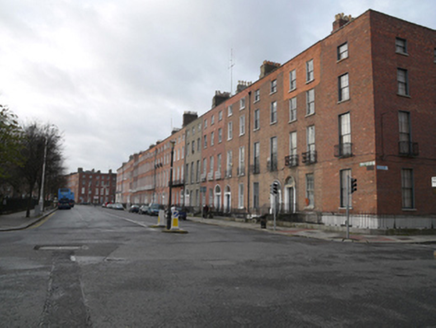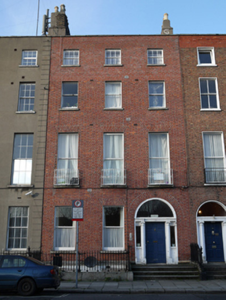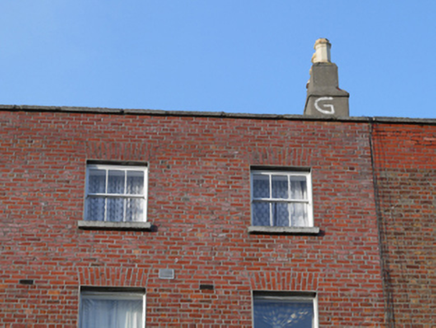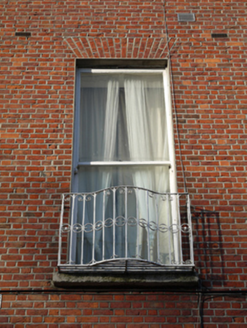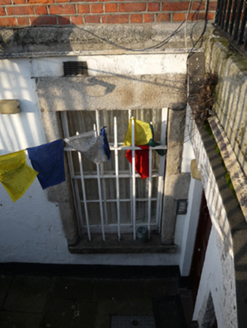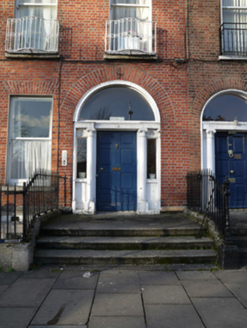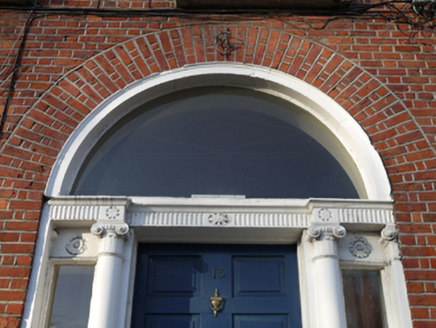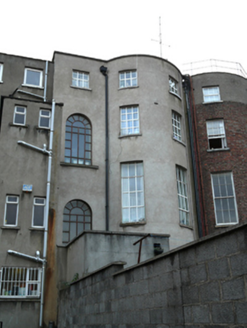Survey Data
Reg No
50010810
Rating
Regional
Categories of Special Interest
Architectural, Artistic
Original Use
House
In Use As
Apartment/flat (converted)
Date
1790 - 1795
Coordinates
316048, 235538
Date Recorded
05/12/2011
Date Updated
--/--/--
Description
Terraced three-bay four-storey house over basement, built c.1792, having full-height bay to rear (north) elevation. Now in multiple occupancy. Double-pile slate roof, pitched to front (south) elevation, with two hipped projections set perpendicular to rear. Shared brown brick and rendered chimneystack having clay pots to west party wall, shared rendered chimneystack with clay pots to east party wall, hidden behind red brick parapet wall having granite coping. Red brick walls laid in Flemish bond with flush pointing to granite plinth course over painted rendered wall to basement. Rendered wall to rear. Gauged brick flat-arch window openings having flush reveals, granite sills and replacement timber sliding sash windows, original eight-over-eight pane with steel grille and replacement casement window to basement, with granite block-and-start architrave surrounds to both, three-over-three pane to top floor and one-over-one pane to lower floors. Wrought-iron bow balconettes to first floor windows. Square and round-headed window openings to rear having flush reveals, granite sills and replacement timber windows. Round-headed door opening with rendered reveal and painted stone Ionic doorcase, and replacement timber panelled door flanked by engaged Ionic columns, plain glazed sidelights having rosettes over and quarter engaged responding Ionic pilasters supporting stepped fluted lintel cornice, with plain fanlight. Door opens onto granite platform with three nosed granite steps bridging basement. Platform and basement enclosed by original wrought-iron railings and cast-iron corner posts set on moulded granite plinth wall to street having matching iron gate providing basement access. Concrete steps and steel railings to basement. Recent timber door under entrance platform.
Appraisal
This building retains a fine early doorcase, enhanced by its sidelights and approached by stone steps and landing. The wrought-iron balconettes add decorative interest. The granite sills and window surrounds to the basement add visual interest. The retention of timber sash windows enhances the architectural heritage quality of the building. Together with its intact setting that includes the stone plinth, railings and gate to the basement area, the building makes a positive contribution to the important urban landscape of Mountjoy Square. Mountjoy Square was built on lands formerly belonging to Saint Mary’s Abbey and laid out in 1790 by Luke Gardiner II, completed by 1818. Originally called Gardiner Square, it was planned to develop a strong vista from Custom House to Mountjoy Square and thence to the planned Royal Circus. Unlike other Georgian squares in the city, this example was more carefully laid out with a unified parapet height and the east-west approaches offset to create a sense of enclosure. After falling into serious neglect and dereliction throughout the twentieth-century resulting in the loss of one third of its original buildings, the square has since been repaired.
